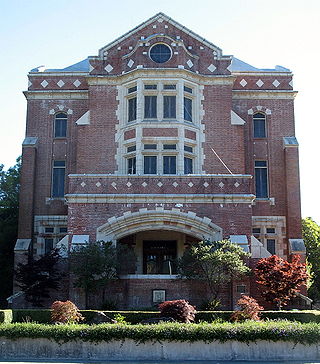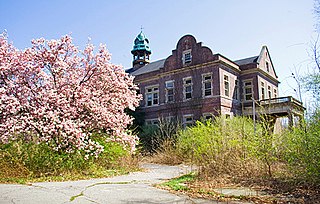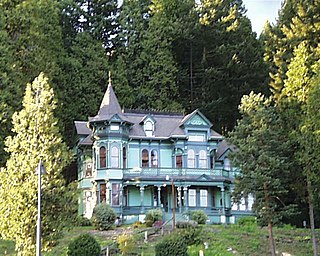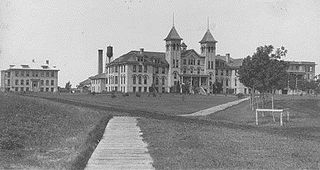The Eugenics Board of North Carolina (EBNC) was a State Board of the U.S. state of North Carolina formed in July 1933 by the North Carolina State Legislature by the passage of House Bill 1013, entitled "An Act to Amend Chapter 34 of the Public Laws of 1929 of North Carolina Relating to the Sterilization of Persons Mentally Defective". This Bill formally repealed a 1929 law, which had been ruled as unconstitutional by the North Carolina Supreme Court earlier in the year.

The Walter E. Fernald State School, later the Walter E. Fernald Developmental Center, was the Western hemisphere's oldest publicly funded institution serving people with developmental disabilities. Under its third superintendent, Walter Fernald, it became a model for state institutions for the developmentally disabled. It later was the scene of medical experiments in the 20th century. Investigations into this research led to new regulations regarding human research in children.

Oregon State Hospital is a public psychiatric hospital in the U.S. state of Oregon, located in the state's capital city of Salem with a smaller satellite campus in Junction City opened in 2014. Founded in 1862 and constructed in the Kirkbride Plan design in 1883, it is the oldest operating psychiatric hospital in the state of Oregon, and one of the oldest continuously operated hospitals on the West Coast.
The Vineland Training School is a non-profit organization in Vineland, New Jersey with the mission of educating people with developmental disabilities so they can live independently. It has been a leader in research and testing.
Elwyn Inc. is a multi-state nonprofit organization based in Elwyn, Pennsylvania, in Middletown Township, Delaware County, Pennsylvania, United States, providing services for children and adults with intellectual and developmental disabilities, and behavioral health challenges. Established in 1852, it provides education, rehabilitation, employment options, child welfare services, assisted living, respite care, campus and community therapeutic residential programs, and other support for daily living. Elwyn has operations in 8 states: Pennsylvania, New Jersey, Delaware, California, Maine, Massachusetts, Rhode Island, and North Carolina.

The Sonoma Developmental Center (SDC) was a large state school in California, United States for people with developmental disabilities, and is located in Eldridge in Sonoma County. Former names for this hospital include California Home for the Care and Training of Feeble Minded Children (1883); Sonoma State Home (1909); Sonoma State Hospital (1953); and Sonoma Developmental Center starting in 1986. The center closed on 31 December 2018.

Pennhurst State School and Hospital, originally known as the Eastern Pennsylvania State Institution for the Feeble-Minded and Epileptic was a state-run institution for mentally and physically disabled individuals of Southeastern Pennsylvania located in Spring City. After 79 years of controversy, it closed on December 9, 1987.

The Rosewood Center was an institution for people with developmental disabilities located on Rosewood Lane in Owings Mills, Maryland.

Walter David Pugh was an American architect based in Salem, Oregon, United States.

The Virginia State Colony for the Epileptics and Feeble Minded was a state run institution for those considered to be “Feeble minded” or those with severe mental impairment. The colony opened in 1910 near Lynchburg, Virginia, in Madison Heights with the goal of isolating those with mental disabilities and other qualities deemed unfit for reproduction away from society. The colony was the home of Carrie Buck, the subject of the landmark Supreme Court case Buck v. Bell.
The Ladd School in Exeter, Rhode Island operated from 1908 to 1993 as a state institution to serve the needs of people with mental disabilities or developmental delays. It was closed largely due to the deinstitutionalization movement of the 1980s.

The Grafton State School on 6th St., W., in Grafton, North Dakota was listed on the National Register of Historic Places in 1996.
Wayne County Training School, alternately known as the Wayne County Training School for Feeble Minded Children or the Wayne County Child Development Center, was a state-funded institution for people with developmental disabilities, located in Northville Township, Michigan. Construction of the institution began in 1923, and it opened in 1926. Expansion on the property continued until 1930. The school closed its doors on October 18, 1974. Most of the buildings were left abandoned until 1998, when the land was sold and the abandoned institution was demolished after that.

Oregon Hospital for the Insane was a facility constructed in the city of Portland, Oregon, USA by medical doctors J. C. Hawthorne and A. M. Loryea. Launched in 1859 as Oregon Hospital, the facility later came to specialize in the treatment of mental illness and served as the de facto insane asylum for the state of Oregon under contract with the Oregon Legislature beginning in 1861.

The Virginia Sterilization Act of 1924 was a U.S. state law in Virginia for the sterilization of institutionalized persons "afflicted with hereditary forms of insanity that are recurrent, idiocy, imbecility, feeble-mindedness or epilepsy”. It greatly influenced the development of eugenics in the twentieth century. The act was based on model legislation written by Harry H. Laughlin and challenged by a case that led to the United States Supreme Court decision of Buck v. Bell. The Supreme Court upheld the law as constitutional and it became a model law for sterilization laws in other states. Justice Holmes wrote that a patient may be sterilized "on complying with the very careful provisions by which the act protects the patients from possible abuse." Between 1924 and 1979, Virginia sterilized over 7,000 individuals under the act. The act was never declared unconstitutional; however, in 2001, the Virginia General Assembly passed a joint resolution apologizing for the misuse of "a respectable, 'scientific' veneer to cover activities of those who held blatantly racist views." In 2015, the Assembly agreed to compensate individuals sterilized under the act.

George Gotthilf Eitel was an American surgeon who designed and built Eitel Hospital in Minneapolis, Minnesota, in 1912. Eitel was its chief of staff for fifteen years until 1927, after which he was called proprietor.
Lanterman Developmental Center, opened under the name the Pacific Colony, was a public psychiatric hospital and a facility serving the needs of people with developmental disabilities, and was located in the San Gabriel Valley in what was once Spadra, California. In 87 years of operation, the hospital served appropriately 14,000 people.
William D. Partlow Developmental Center, also known as the Partlow State School and Hospital, was a state school for people with mental disabilities, primarily intellectual and developmental disabilities in Tuscaloosa, Alabama, US. It was operated by the Alabama Department of Mental Health. It was the last such full-sized facility operated by the State of Alabama and closed in 2011.
State schools are a type of institution for people with intellectual and developmental disabilities in the United States. These institutions are run by individual states. These state schools were and are famous for abuse and neglect. In many states, the residents were involuntary sterilized during the eugenics era. Many states have closed state schools as part of the deinstitutionalisation movement.












